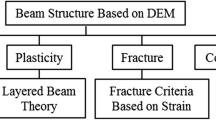Abstract
The three-dimensional mode-deformable discrete element method (3MDEM) is an extended distinct element approach under the assumptions of small strain, finite displacement, and finite rotation of blocks. The deformation of blocks is expressed by the combination of the deformation modes in 3MDEM. In this paper, the elastoplastic constitutive relationship of blocks is implemented on the 3MDEM platform to simulate the integrated process from elasticity to plasticity and finally to fracture. To overcome the shortcomings of the conventional criterion for contact fracturing, a new criterion based on plastic strain is introduced. This approach is verified by two numerical examples. Finally, a cantilever beam is simulated as a comprehensive case study, which went through elastic, elastoplastic, and discontinuous fracture stages.
Similar content being viewed by others
References
Cundall P A. Computer model for simulating progressive large scale movements in blocky systems. Proc. Symp. Int. Soci. Rock Mech., Nancy, France, Vol. 1, paper No II-8, 1971
Cundall P A. Formulation of a three-dimensional distinct element model—Part I. A scheme to detect and represent contacts in a system composed of many polyhedral blocks. International Journal of Rock Mechanics and Mining Sciences & Geomechanics Abstracts, 1988, 25(3): 107–116
Hart R, Cundall P A, Lemos J. Formulation of a three-dimensional distinct element model—Part II. Mechanical calculations for motion and interaction of a system composed of many polyhedral blocks. International Journal of Rock Mechanics and Mining Sciences & Geomechanics Abstracts, 1988, 25(3): 117–125
Cundall P A. UDEC-A generalized discrete element program of modeling jointed rock. European Research Office, U.S. Army, 1980
Itasca, 3DEC — 3 Dimensional Discrete Element Code, Version 3.0, User’s Manual, Itasca Consulting Group, Inc. USA. 1996
Williams J R, Hocking G, Mustoe G G W. The theoretical basis of the discrete element method, Proceedings of the NUMETA conference, Swansea, 1985, 7–11
Williams J R, Mustoe G G W. Modal methods for the analysis of discrete systems. Computers and Geotechnics, 1987, 4(1): 1–19
Shi G H. Discontinuous Deformation Analysis — A New Numerical Model for the Statics and Dynamics of Block Systems, Lawrence Berkeley Laboratory, Report to DOE OWTD, ContractAC03-76SF0098, September 1988; also DissertationTip, University of California, Berkeley, August, 1989
Cundall P A, Marti J, Beresford P J, Last N C, Asgian M I. Computer Modeling of Jointed Rock Masses, U.S. Army Engineer Waterways Experiment Station, Vicksburg, Mississippi, Tech. Report N-78-4, August, 1978
Genhua S. Discontinuous deformation analysis: A new numerical model for the statics and dynamics of deformable block structures, Engineering Computations, 1992. 9
Chong Z, Feng J, Yanli H. 3-D simple deformable distinct element method. Chinese Journal of Geotechnical Engineering, 2007, 29(4): 6–10 (in Chinese)
Jin F, Zhang C, Hu W, Wang J. 3-D mode discrete element method: elastic model. International Journal of Rock Mechanics and Mining Sciences, 2011, 48(1): 59–66
Author information
Authors and Affiliations
Corresponding author
Additional information
Feng Jin is a Professor and the chair of the Department of Hydraulic Engineering, Tsinghua University, was born in September 1966 in Zunyi, Guizhou Province, China. He graduated from Tsinghua University majoring in Hydraulic Structures and Solid Mechanics in 1987 and completed the Ph.D. degree in Hydraulic Structures in 1992. As a visiting scientist, he conducted research at the Concordia University, Canada in 1996. He is the Executive editor in chief of the journal Frontiers of Structural and Civil Engineering, and also the member of editorial board of the Chinese journal Advances in Science and Technology of Water Resources, Engineering Mechanics, Journal of Hydraulic Engineering, and Water Resources and Power. He is engaged in research on seismic analysis of dams and materials of Rock-Fill Concrete. He has published more than 200 papers and three books, including Tsinghua University Treatise: Discrete-Contact-Fracture Analysis of Rock and Concrete. He received 10 prizes including the National Natural Science Prize, State Science and Technology Progress Prize, etc.
Rights and permissions
About this article
Cite this article
Hu, W., Jin, F., Zhang, C. et al. 3D mode discrete element method with the elastoplastic model. Front. Struct. Civ. Eng. 6, 57–68 (2012). https://doi.org/10.1007/s11709-012-0139-9
Received:
Accepted:
Published:
Issue Date:
DOI: https://doi.org/10.1007/s11709-012-0139-9




